The new-vehicle shortages of 2021-2022 now mean lower supply to the used-vehicle market, amid solid demand.
By Wolf Richter for WOLF STREET.
Used-vehicle prices, which had spiked over the two-year span 2020-2021 by 65% on the wholesale side and by 55% on the retail side, provided rocket fuel to inflation. Then, as prices careened down in 2022 through 2023, giving up about half of the wholesale price spike and about a third of the retail price spike, they contributed to the sharp deflation in durable goods that helped decelerate overall inflation. But this drop in used-vehicle prices petered out in 2024, amid solid demand facing tight inventories due to reduced supply from rental fleets and lease terminations.
Prices of used vehicle sold at auctions across the US dipped a little in December from November, both seasonally adjusted and not seasonally adjusted, but dipped less than in December 2023, which turned the long series of year-over-year declines into year-over-year increases for both measures for the first time since August 2022, when the crazy price spiral had begun to unwind.
Seasonally adjusted, prices in November had inched up to the highest level since October 2023, and in December, backed off by $89, to the second highest level since October 2023 (red line), according to the Manheim Used Vehicle Value Index, which is adjusted for changes in mix and mileage. Manheim is the largest auto auction house in the US and a unit of Cox Automotive.
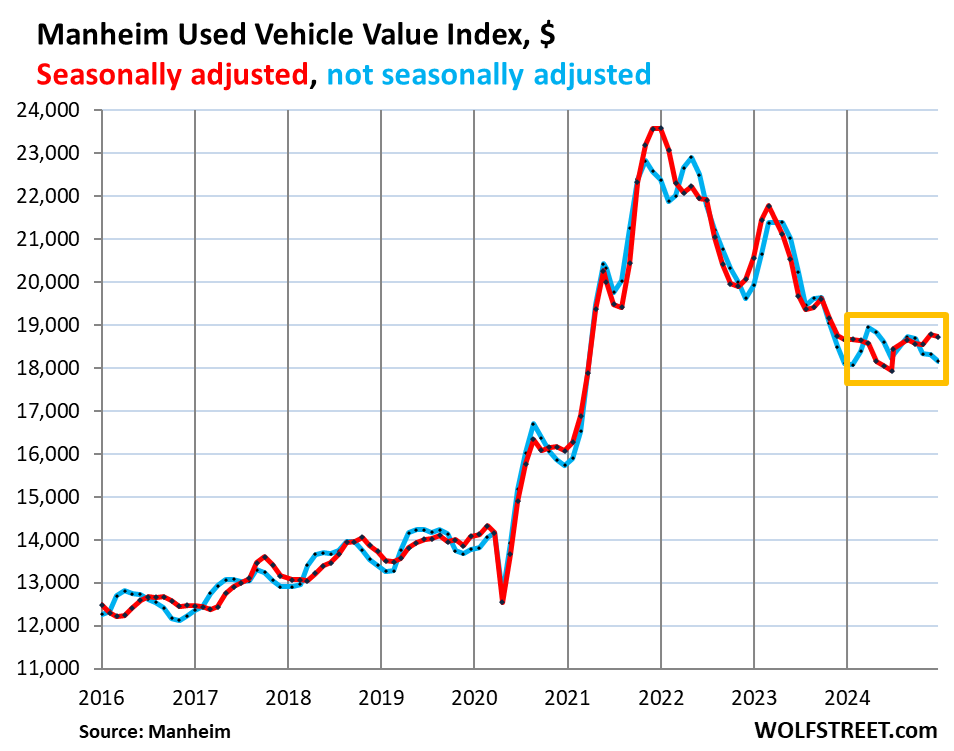
On a year-over-year basis, these first year-over-year upticks after a long and steep series of year-over-year declines that had maxed out at about 15% twice – in November 2023 and in March 2024 – indicate that this crazy pricing behavior has now settled down into some sort of normalcy, and that used-vehicle prices no longer contribute to the cooling of inflation, and we have already seen that.
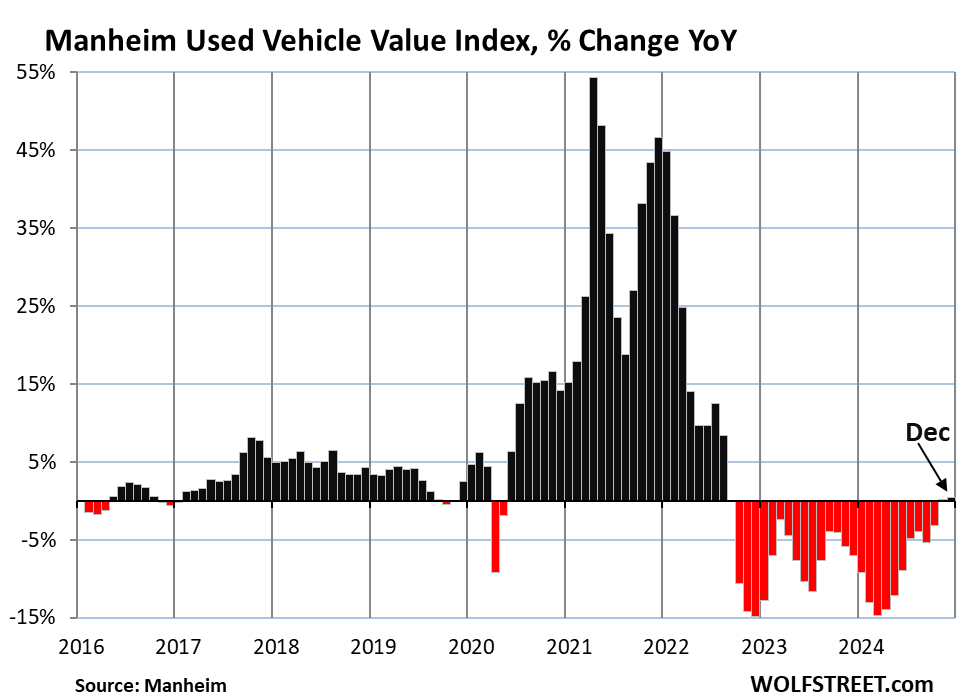
Prices are still too high, by powertrain: ICE and EV.
Used ICE-vehicle wholesale prices had spiked by 64% in 2020-2021, but used EV prices had spiked by 145% over the same period, a testimony of the crazy behavior by buyers, armed with free money, such as to-be-forgiven PPP loans. This kind of stuff should have never happened.
Prices have since then come down, but not nearly enough. ICE-vehicle prices (blue) are still 31% higher than they’d been at the end of 2019, and EV prices are still a massive 74% higher (red).
This is an example of the “inflation shock,” as it’s now called, that consumers are still dealing with:
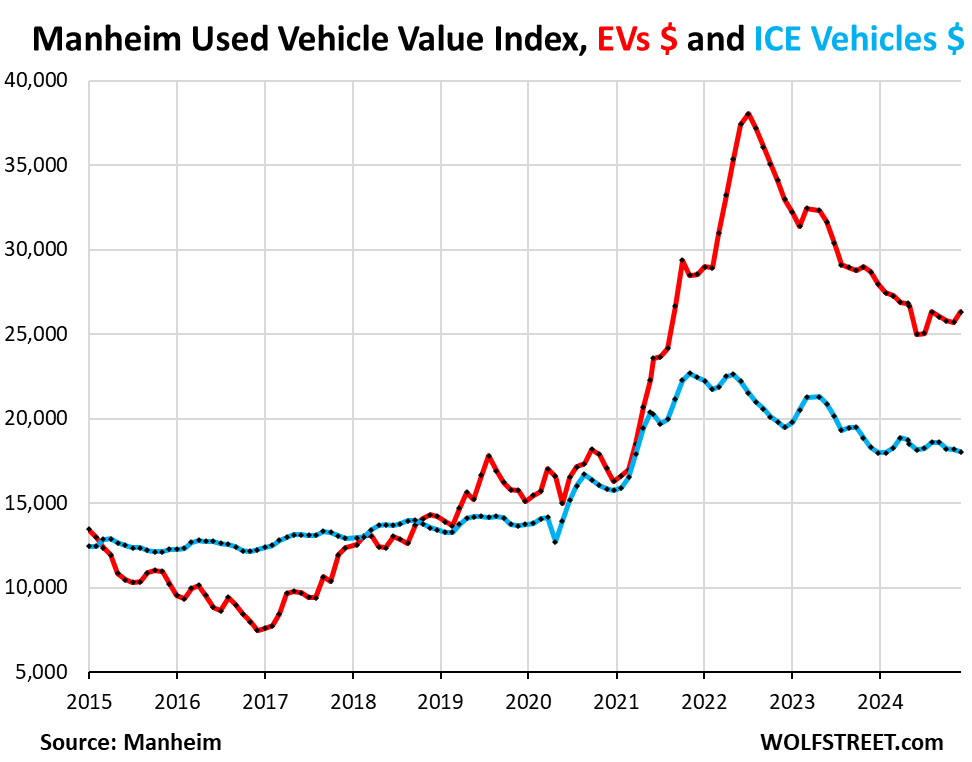
Dealers buy at these auctions to replenish their used-vehicle inventories. Supply comes from rental fleets that sell some of the vehicles they pull out of service, from finance companies that sell their off-lease vehicles and repos, from corporate and government fleets, other dealers, etc.
So prices are still very high, but they have stopped falling amid tight supply and solid demand. Supply is tight because automakers, waylaid by semiconductor shortages, had cut production globally in 2021 and 2022, causing new-vehicle sales in the US to plunge as dealers ran out of vehicles to sell.
Roughly 6 to 10 million fewer new-vehicles were sold in the US over the two-year period, and they’re now missing from the national fleet, and that shortfall has begun to migrate to the supply of used vehicles.
Rental fleets form part of the supply to the used-vehicle market about 1-3 years later when those units get taken out of service. But in 2021 and 2022, they couldn’t get enough new vehicles for their fleets, and so now, supply from rental fleets is falling short.
And leasing activity in 2021 and 2022 plunged, and so the number of leases that are now maturing has plunged, and so supply from leasing companies, when they sell the two and three-year-old off-lease vehicles at auctions, has plunged.
These used-vehicle supply issues, a consequence of the new-vehicle shortages in 2021 and 2022, will drag into 2026.
Retail inventories are tight amid supply issues and solid demand. At the start of December, inventory at used-vehicle dealers remained at about 2.18 million units, roughly unchanged from the prior month, and down by about 26% from the same period in 2019, according to data from Cox Automotive.
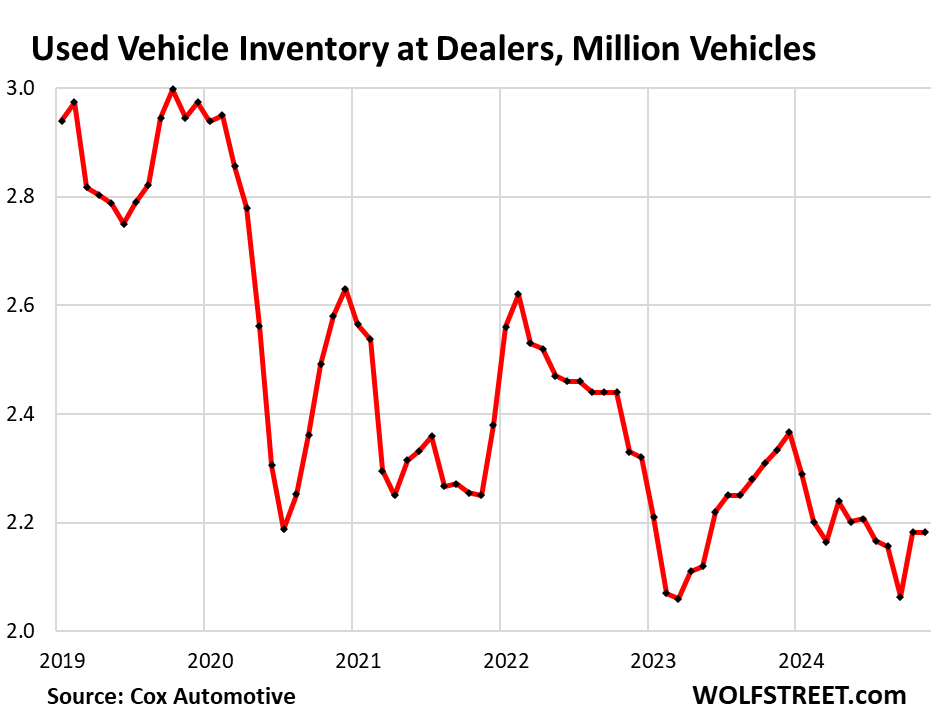
Used-vehicle retail sales have risen by the double-digits year-over-year over the past few months, and in December by 13%, based on observed changes in vehicles tracked by vAuto, a unit of Cox Automotive.
Pushing up into inflation figures.
From the beginning of 2022 through the summer of 2024, the CPI for used vehicle plunged by 28%, giving up half of the two-year price spike, which was a powerful contributor to the cooling of core inflation figures. But that ended in mid-2024.
CPI for used vehicles, which lags wholesale prices by a couple of months, bottomed out in August and has since been rising, seasonally adjusted and not seasonally adjusted. Over the three months September through November, the CPI for used vehicles, seasonally adjusted, jumped by 5.1%, which was a big move (red). December CPI will be released next week for the next installment of this story.
Year-over-year, CPI for used vehicles was still down 3.4% in November, but over the next few months, the year-over-year readings too will turn positive, just based on where they’d been a year earlier.
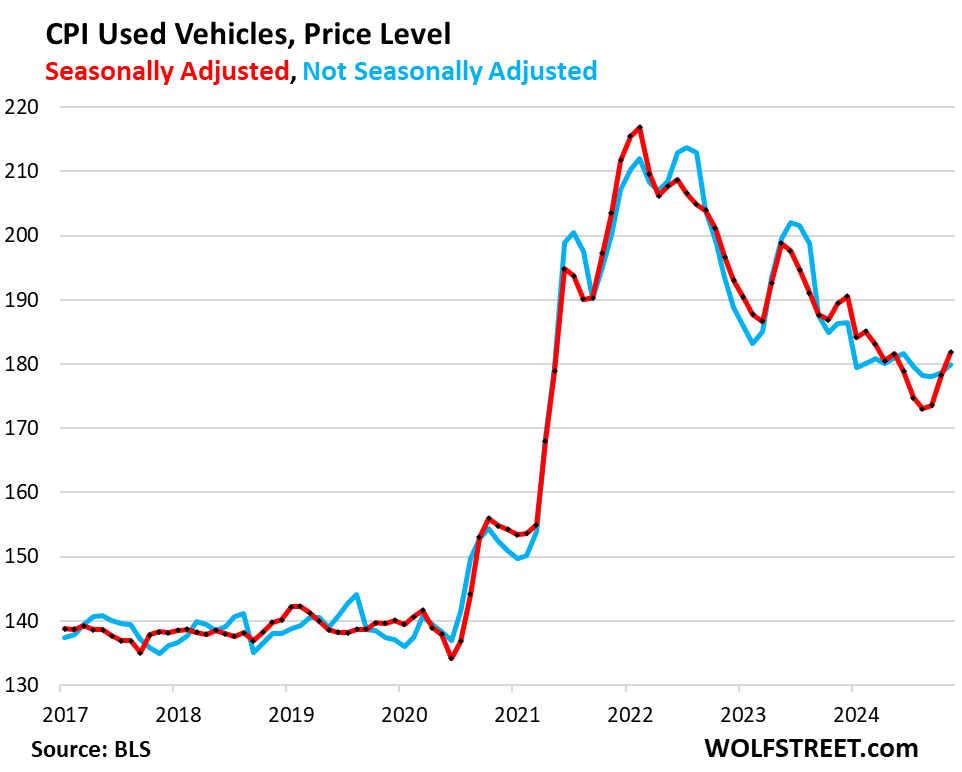
Enjoy reading WOLF STREET and want to support it? You can donate. I appreciate it immensely. Click on the mug to find out how:
![]()


I would be hard pressed to come up with ANY vehicle sold in America the last few years I would even want.
Now,let me at some overseas cars and especially trucks without import hassle and I might be interested.
Me daily driver getting very long in the tooth,looking to find if possible a diesel rabbit from the 80’s with standard,had one ages ago and loved it!I would also be open to a rear wheel drive Celica with 20-22R motor in good shape.
Till then,stick with me built up 4×4’s from the 80’s.
Sometime in the 80’s sadly the era of simple vehicles died. My first car was a 78 Gremlin followed by a 79 Firebird. Most of which even as a teenager I could do most of the work myself. It would be nice to see a return to a lower tech offering that provides 90% self-repair options.
Both of those were awesome cars 👍🏻. I miss those days 😔
You have nailed it. Cars cannot be worked on by humans anymore. I loved my good ole ’78 Gremlin too. Of my five vehicles, the 2002 BMW Touring Sedan is the newest and most problematic. Screw the EPA crap and every stinking Democrat.
Wolf seems to think that I will die in my 1999 GMC or my 1937 Cord.
We will see.
You must live somewhere that things don’t rust. I have a 90s minivan and a TDI wagon parked for the winter or else road salt would eat them alive. If you’re in the market for 80s vehicles, then look at legitimate importers because they only have to be 25 years old to be eligible for import.
Dave,live in north east so am very aware of having cars down3-4 months yearly.That said,I do under oil the daily drivers and really since I no longer plow and am semi retired just have no need to drive in snow short of a true emergency.
I do buy out of other parts of the country,have family/friends in Cali. and Az. but even there the old stuff fading.
Really like the look of the basic Toyota hi lux but would have to smuggle in somehow!
Do you find that if you don’t drive in the heavy snow/salt, that your vehicles aren’t really affected? I have a 95 thats not rusty and i am wondering if i should try to leave it parked until April or if i should just avoid the slush and snow days with it. I wasn’t sure on the actual answer. Previously I’ve just let all my vehicles rust.
BMWs simply keep getting better and better all the time and BMW has a spectacular array of new vehicles for sale as well as wonderful classics that keep going for higher prices every day on sites like BAT. I would you embrace the future and look for a truly superb car or cars from BMW which has always made the ultimate driving machines.
“BMWs simply keep getting better and better”
The giant tablet screen that you are FORCED to buy in all the newer cars is gross and unsafe.
Agree TLT: those big tv touchscreens are terribly unsightly, furthermore, no more safe to look away from the road to that screen to adjust something than looking at a cell phone, which is illegal to do now in many states.
Lifespan of BMW engines is shorter and shorter. The best example: timing chain in N47, but there’re many others.
Good engines? Japanese or korean. Chinese? Let’s see.
Goldenome,
Also note rear windows are now much smaller “because backup cameras”
Even if their cars are great, the people who drive them tend to be the worst, most entitled drivers on the road.
Just that alone would keep me from buying. Not every BMW driver is a jerk, but jerks tend to buy the brand in droves.
Really curious where you live? Maybe in a more modest area where having a BMW would be a status symbol?
I feel like where I live, having a BMW is no different than having an old Toyota (I do like BMWs, though).
SCBD,
Surely you can’t be a fan of all the FAKE exhaust tips that the German mfgrs are putting on their cars… although MB is arguably the worst offender here (and I admit Honda isn’t innocent either).
I laugh everytime I see those giant fake exhaust tips which are followed by dinky 2″ pipes and restrictive resonators. My single-pipe 3″ exhaust is less restrictive.
As long as all pipes smoke, at least.
Lost it’s soul, completely. Friend had an 83 3 series coupe with a stick shift. All I’d ever need and more. Cheap money and a form over function country willing to buy bling they don’t need with money they don’t have has screwed us folks looking for transportation appliances.
I beg to differ Socal, long time BMW guy here, BMW died after 2015-2017. Their latest designer/director needs to be fired, he was horrific.
Still in the market for a 328 diesel wagon, at least the gauge cluster is still amber before they moved to white gauges and removed the hoffmeister kink from the rear window design.
Hi Wolf. I can confirm that this is playing out just like the charts at my dealership. We leased so few cars in 21-22 that lease returns have pretty evaporated. It started to get better in 23, but most of the lease deals were on EVs because the deals were so sweet. They were mostly 24 month leases. Those cars will start to come back this year. The off lease prices are about 50% of the original MSRP. So there will be some good deals. My guess is that this will bring some of the pressure down on the used EV pricing later this year.
The Hondas and Toyotas I am looking at are still holding 75% of their original price in my area after 3 years.
Are these lease return EVs being sold as certified used to the next owner, with a few years of warranty (and equivalent mileage)? I can imagine someone being comfortable in a 2023 VW ID4 or the like if it has full bumper to bumper coverage including the battery for several years. The question then becomes what value does the car have at 6-7 years old and 100k miles? Any trade in value? Maybe the second owner under the certified used plan is effectively the last owner and the car is basically at recycling value after that. Who would buy a six year old EV? Maybe at 10% of original MSRP? A third car to run to the store nearby.
“Are these lease return EVs being sold as certified used to the next owner, with a few years of warranty (and equivalent mileage)?”
Yes, the factory warranty always stays with the vehicle when it changes ownership, so the buyer will get the remaining factory warranty.
“what value does the car have at 6-7 years old and 100k miles?… Who would buy a six year old EV?”
Just google the prices for 2018 Model 3 Tesla…. you’ll see right at the top for sale at $14k-$22K. Kelly Blue Book national average retail is $21,800 for a 2018 Model 3. By comparison, the KBB average for a 2018 BMW 3-series, which competes directly with the Model 3, is $11,200 (trade-in value of $7,700).
These used Tesla prices are HUGE prices for cars that old. You can buy a brand-new 2025 Model 3 in the $30s after rebate.
Hertz has been selling lots of heavily used high-mileage rental Teslas in their own dealerships around the country and online, been doing for many months, and they’re selling at very high prices for their milage, so I’ve been watching them as a good indicator for high-mileage EVs. For example, a 2022 base Model 3 with 132,000 miles selling for $19K, or a 2022 base Model 3 with 155,000 miles selling for $18k. These are ridiculous prices for this high-mileage beat-up rental iron. But Hertz is getting those prices because people are nuts and are overpaying out of their nose for used EVs, as the chart above shows you.
ALL used car prices are still way too high, and particularly used EVs, and they should fall a lot further, but it doesn’t look like they will.
But there may be a new thing happening here: since EVs with 155,000 miles don’t have much of a risk of powertrain problems, unlike ICE vehicles (which can get hugely expensive), and since even at their advanced mileage, they’re relatively low maintenance, and since batteries are holding up surprisingly well, it just may be that EVs have much higher used prices than equivalent-mileage ICE vehicles. I’ve been watching this develop. We’re now getting a broader range of used EVs flowing through the market and we’re getting more volume… it’s not just Teslas anymore. So this will be an interesting thing to observe over time.
I think Tesla’s are a different animal. People will pay more because of the charging network and reputation. Plus its easier to qualify for tax credits on used Tesla’s. At MB I have a 23 EV that was 83k new. It has 15k miles and is $39k certified. Only took a couple days to sell. Pretty good deal I would say. Other manufacturers just ramped up EV production a few years ago so it will take some time. Also, imagine if some new battery technology comes out that greatly increases range. That will put downward pressure on prices of used EVs as well.
MW: Wall Street’s riskiest stocks melt down in ‘day of reckoning’ for retail traders
I had heard it would take 3-5 years for used cars to normalize. Still another year at least to go.
I also wonder if/how the new administration will change EV subsidies and what effect that might have on prices. I’m guessing that either MSRP on EVs will drop a bit or fewer EVs will get sold if subsidies are reduced/removed. They’re still a luxury item though, so maybe it won’t make much difference on the mid- to high-end models.
Wolf – I’m in the auto industry. While not directly impacting 2025, we are expecting to see a 5x increase on EV lease returns come 2026. Honda, Chevy, etc. running $99/mo. or $129/mo. leases these last 2 years will cause a HUGE glut of EV inventory in the next year or two.
Buckle up, there will be a significant number of EV lease return bag holders here soon. Race to the bottom on lease pricing = race to the bottom on EV prices coming back. 100% certain that EV demand will not support this amount of lease returns. I would expect this inflationary pressure to resolve itself soon.
A “huge glut” of any used vehicles would be great to bring prices down. Prices of used vehicles are way too high, especially used EV prices which are still sky-high. I mean look at the 2022 base Model 3 with 132,000 miles that Hertz is selling for $19K, or that 2022 base Model 3 with 155,000 miles that it’s selling for $18k. These are ridiculous prices for this high-mileage iron. But Hertz is getting those prices because people are nuts and are overpaying out of their nose for used Teslas, as the chart above shows you. So a glut of used EVs would be great to bring those prices down.
But, but, but… BS? Honda just started selling EVs, LOL, it has 1 EV model at dealers right now, and it’s not making many of them, and is only selling a few of them, so there is going to be a “glut” with the few EVs it’s now selling???? I told you how many EVs all of GM sold in the entire year 2024 in a prior article, namely 114,000 all of GM, and only a portion of them were Chevrolets, and only a portion of those were leased. It will sell more in 2025, but still small numbers, so a glut with a small number of units? Tesla still sells more than all other EV makers combined. Franchised and independent dealers will sell about 20 million used retail units in 2025, and about as many in 2026, and the used EVs will create a glut among the 20 million sales? You gotta be kidding. There is plenty of demand for used EVs, which is why their prices are still so damn high.
These high residual values for EVs are also the reason the lease payments can be so low.
Wolf, don’t forget the new Acura ZDX.
Not that I think it will cause a glut, but nice to see Honda/Acura finally in the EV game.
Keep in mind that the Prologue (Honda) and ZDX (Acura) are basically just rebadged GM product. This is a mild oversimplification, but do your own research to determine how mild…
Surprising for Honda to do this again. Their original Passport (mid-90s) was a rebadged Isuzu and it tanked in the secondary market.
” Prologue (Honda) and ZDX (Acura) are basically just rebadged GM product”
I hadn’t heard this before – which GM platform specifically?
I guess it’s not too far out for American Honda Co to copy a Detroit mfgr.
They’re all built on GM’s Ultium platform, a simple but effective 3-motor battery/skateboard.
Prologue=Blazer – Both built on the same line in Coahuila Mexico
ZDX=Lyric – From the revamped Saturn plant in Spring Hill TN
To your final point – OEMs are not immune to sharing when they can make it feel like a win-win. It’s actually quite common. In this case Honda/Acura gets EVs on the lot right now and GM gets to run their lines, increasing production efficiency without the cost of carrying the product. Also helps that there’s basically zero cross shop between Honda and GM so the typical Honda buyer would never know any of this without doing the work.
If you’re really a Honda person though, hold tight for their collaboration with Sony (AFEELA) in ’26. But don’t look for them in the showrooms, they started an entirely new company to circumvent the restrictions of US dealer network (a la Tesla).
FBEM,
Thanks for the explanation.
I am indeed a honda fanboy I mean person. Luckily I have no plans to buy anything that new. I’m hoping to have enough saved up for a good condition, unmodded FK8 Civic R sometime around 2030. Also pulling the trigger on an SCL500 next summer. Vroom vroom.
Thank you WR. I have been eyeing a Tesla but I don’t really need it until the fall so I’ll give it a wait.
I realize things can go either way, but this is good info.
CNBC: FED SOUNDS INFLATION WARNING…
I am intrigued to see what will happen to used prices with the price drop coming from Stellantis for 2025 models. A new 2025 is pretty close to used 2024 prices already.
I work for a state government entity and manage a small vehicle fleet of about 50 leased vehicles. During the pandemic, we were getting one-year leases on both Ford and Chevy half-ton trucks and flipping them right before the lease terms and we’re actually making serious money doing it (all at the counsel of our leasing company). We were literally getting paid to drive brand new vehicles. We’re a bit of an anomaly as we’d max out a vehicle’s mileage at maybe 2,500 per year… Most of them we only did one oil change just as a courtesy before turning them in.
However, now with the glut of new trucks and higher interest rates, we are moving to 5-year leases because that math no longer works… Plus it’s a ginormous pain to swap all those vehicles.
I’d guess that’s a pretty common story for a lot of the government fleets in particular as they use the various government discounts / tax free / pricing etc to obtain their units. In the end, at some point, it will all get back to some semblance of routine or normal inventory patterns barring external craziness. It’s anecdotal but I do wonder if governments holding onto their vehicles (a little longer) will also contribute to small pricing increases, or at least preventing further price drops, in the used markets, especially for pickup trucks.
Vehicle are going to be much more expensive when the repair parts prices double. So much Chinese j.i.t. crap. Further, until we allow the bottom end to get a lot of new cheaper inventory, prices for used will remain high. I am amazed at the value of a 15 year old car with 100k miles.
Someday this war’s gonna end, but inflation, never.
We don’t have the Chinese crap because of tariffs and the parts we do get are high, because of the tariffs. Without tariffs we would have $15k cars for sale off the lot brand new. But that would hurt local manufacturers that only sell over priced trucks while Chinese crap would not just be cheap but highly fuel efficient.
US can’t compete with well made cars. It doesn’t need to because our people buy trucks. But if we had $15k cars that lasted even a moderate amount, how many people would consider abandoning those $50?-$60k trucks?
There were some small cars in the US in that range by all major automakers, including Toyota (Yaris) and Ford (Fiesta). They were discontinued in recent years due to very slow sales. Americans don’t like small cars. And they weren’t bare-bones either. They came with lots of goodies and were nice cars. To make a small cheap car economically viable, the automaker has to sell many hundreds of thousands per year, not 50,000 a year. And that never happened. Not enough Americans bought them. But they bought hundreds of thousands of each of the big models. The US is that kind of market.
Shop labor has gone thru the roof in terms of cost too.
And how do they work on all those newer cars with the gazillion sensors and computer chips…?
Everyone slams on technology and sensors in vehicles. Yes there are some complexities and expenses that arise with the use of these things, but what people often forget are, since the introduction of OBDII and diagnostics info, theres some serious advantages today vs long ago. Cars last longer now, thats essentially a fact aside from exceptions, and often times today when there is an issue, because of all the sensors/tech/etc, the car can actually advise you what is wrong. Many dealerships/garages simply read the DTC code, and know exactly what part needs to be replaced. Yes it isnt always that cut and dry, but sometimes it is! Long ago, you used to have to guess whether it was the carb, the spark plugs, the distributor, etc that was causing the car to run funny. Nowadays, the system is enabled to actually report it out to you. Is it perfect, well no. But everyone hates on this tech, sometimes i feel its a little unwarranted in the grand scheme of things. Rarely does anyone praise the benefits of not having to rebuild their varnished carbs today or deal with choke and leaks, because of what fuel injection has brought them. They only complain when it breaks.
I’m not anti-tech. I have a USB to OBDII dongle and reflashed my car’s ECU. I also taught myself VTEC tuning. You don’t get the same amount of benefit from performance parts unless you also have a proper tune that compensates for the increased airflow.
And having had a carbureted bike, I certainly know the value of electronic fuel injection – who wants to swap out their carb jets everytime the temperature changes?
But why do I need a giant tablet screen on the dash?
Why do I need the steering wheel to wiggle if it thinks I’m departing a lane?
Why do I need my car to be on wifi for ‘updates’ to its software?
Why do I need an NFC sensor for my keyless keyfob when I can just… stick a key in the ignition and turn it??
I need none of those, and personally am happy to do without them. Personally I could even do without power seats, but I won’t get too carried away with this rant.
I want to own my car rather than my car owning me…
“Long ago, you used to have to guess whether it was the carb, the spark plugs, the distributor, etc that was causing the car to run funny.”
Not much has changed – the same is still true of suspension.
Getting a noise when you hit the brakes? Turn the wheel? Could be a bad tie rod (or the entire pwr steering rack)… bad ball joint or bushing on the control arm…. bad CV joint… bad intermediate axle… bad brake calliper… bad strut mount.
There are no sensors to diagnose such an issue. You either have an intuition and figure it out, or you throw parts at your car until the noise stops. I recently did the latter with mine.
Yes you don’t need all that. And you don’t need sensors on your suspension. However, you do need proximity sensors and cameras and temp sensors etc if you ever want your cars to drive themselves, or at least get closer to it. And people are willing to pay a premium for that, and automakers are going to respond by selling it to them. I don’t need tire pressure sensors, I can get out and check them with a gauge, but damn for the $5 each of technology it takes to never have to do that again…man I’ll take it! It sucks when they break, but I’m only back at square one, other than a new shining light. Don’t hate the tech, hate the manufacturers for not implementing it right or using sufficient quality. You folks that wish away all this tech are like the old folks who want manual transmissions and hand crank windows. There’s nothing wrong with that….but you have to face the facts that you’re a minority in that desire. And carmakers don’t build for the minority, they have to stay competitive and cutting edge or they get left behind. However, if they make crap, they will also be left behind.
TPMS sensors aren’t exactly new. 20+ year old tech. My ’03 TL had them.
But you’re right about distinguishing badly implemented tech from tech in general – it just feels like a lot of modern tech is badly implemented. Exhibit A:
My 2011 RDX tells me the actual pressure readout from all four TPMS sensors just like you describe. But the wife’s 2019 HRV just has a low tire pressure warning that comes on when they’re low – it doesn’t display the actual pressure readout (I don’t even think it tells you which tire is low).
The ECU is obviously recieving all this data to know when to display the warning, but the car’s software wasn’t coded to display it to the driver, and you still have to get out and measure.
Stupid.
So many of these sensors are just for emissions reasons too. The only reason you need a defouler when running a catless downpipe is because removing the cat sensor throws a CEL and then you’ll fail your yearly inspection. It’s not like there’s anything wrong with running the engine that way.
I know guys with mods who, come inspection time, throw in their stock downpipe, clear the code, get a sticker, and then replace it with the catless DP and drive the rest of the year with a CEL.
Keep in mind that Private Equity has been buying up auto shops along with anything else they can get their grubby paws on. The one we used to go to got bought out and the price of a lube, oil, filter more than doubled overnight. Not only that, but that fantastic guy who ran the main office bailed and was replaced by someone nowhere near as good.
Needless to say, we moved on to another vendor. PE has also been buying up veterinarians, so if the price to have your furry friends care for has dramatically increased (and the long time staff has left), you know why.
One simple rule of thumb – used vehicle prices are positively correlated with new vehicle sales (SAAR) in the near term and negatively correlated with new unit SAAR ~20-30 months out. This is not a theory, it’s just math and you can prove it out for yourself with FRED data (ALTSALES, CUSR0000SETA02) and excel. I can expand more on the hypothesis behind this observation if there’s interest.
Right now we’re getting it from both directions – increasing current SAAR (>16.5MM Nov/Dec) on top of very low SAAR (13-15MM) 2-3 years back.
The wild card is new unit incentives which are increasing, but still well below pre-pandemic norms – 7-8% now vs 11-12% pre-2020. But if they can sell ~17MM new units with <10% incentives don't look for much relief on used prices until supply bounces in a couple of years.
If proposed tariffs and other economic threats disrupt the new car production supply chain then used cars will also increase in cost. Furthermore, retaliatory tariffs on key materials and components will also be an inflationary add on.
Unintended consequences loom, imho.
Any idea how long various governments typically hold onto their vehicles before turning them over to auction?
Two old anecdotal reports: Purchased a 1984 Chevy 3/4 T pick up in 1994 that had just gone to auction from a city in FL. It served well until 2019, and I have minor regrets for actually giving it away then.
Somewhat similarly, bought an at least 10 YO International 1/2 T 4×4 from the US Forest Service at their auction in ID in1977.
Both really great trucks and IMO at the time, really good deals.
Both lasted and served well until I gave them away to folx I thought would take care of them.
In terms of passenger vehicles, the biggest fleets BY FAR are the combined rental fleets. They matter massively for the used vehicle market. Before the pandemic, they bought between 2.5 and 3.5 million new vehicles a year, and would supply the used-vehicle market directly or indirectly with about as many. Most have their own dealerships and sell their “rental risk” units directly to consumers through their dealerships. If they cannot sell their rental risk units quickly at their dealerships, they sell them wholesale to other dealers, such as CarMax and Carvana, and through auctions. The “program” units go back to the automaker in a pre-arranged deal, which the automakers then sell at auctions. Government purchases pale compared to rental fleets. Rental fleets is what you have to keep your eyes on in terms of fleet units.
Wolf,
Any data on the ratio (unit sales) of new vehicles:used vehicles sold during a given time period?
I’m curious if there’s a shift towards used – because of too-high prices, a buyer who formerly would have bought new is now buying used instead.
And/or, if there’s demand for older vehicles specifically (or maybe not, and I’m just unique in my disdain for newer cars).
Wolf,
Thank you. Always fascinating. Given your prior life managing the dealership, I always read these ones closely.
I bought a new work vehicle this year and was lucky enough to talk with the manager for a few minutes. Paperwork took until after closing on a Saturday and so they were all over it too keep things moving. He implied that I was getting a great deal because the floor plan financing was too expensive and they had to move inventory.
Is this potentially why inventory appears to be so low?
GK
Nah, just a salesman talking. It’s just for entertainment purposes. Don’t take it seriously.
My finance professor said the only thing you should buy on time in your life is your house. So, if you want a new car, pay cash or buy a used one. AAA will tow your car to a mechanic of your choice.
“Inflation is always and everywhere a monetary phenomenon.” Milton Friedman
Higher prices are caused by inflation. Inflation is not caused by higher prices.
Bullshit. Inflation = rate of change of prices.
What causes inflation is another question, and despite the quote from Friedman, it’s caused by a complex combination of events, including mass psychology (the inflationary mindset).
In its 2024 Your Driving Costs study, AAA says average ownership costs for a new vehicle driven 15,000 miles annually is $12,297 a year, or $1,024 a month. That’s an increase of $115 since last year’s study. 5 years = $65,000 or 7 years=$90,000. The true cost of ownership is now astronomical for everyday American family. Holding on to my 2007 205,000 mileage vehicle until the RTF mode kicks in.
Yep. Working remote with 1 car now in the household instead of 2, we very much see this benefit of not having to pay for the up front and operational costs. I now throw the burden on anyone trying to recruit in office as they will need to pay minimum about $15-20k more than I make now (due to the pre tax nature of cover those costs you lay out) and that doesn’t even account for my loss in time that also I expect to be compensated for.
All that to say, is prices are too high, and companies pushing for return to office are out of their minds. Markets aren’t always accurate in the short term, but in the long term, they are always efficient
what effects do the fires in CA and the hurricane flooding in the south have on used car supply and demand, in terms of damaged/destroyed cars?
All of you clowns that think you need the latest in technology in cars deserve what you get. Drive your goddamn cars.